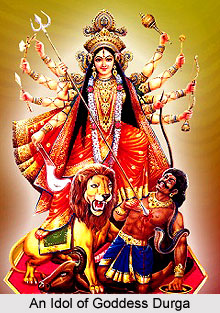 Agamani or the "Songs of advent" and Vijaya or "Songs of parting" are actually types of genres of various popular Bengali folk songs that are celebrated with the return of the Goddess Parvati to the home of her parents on the eve of the Bengali autumn Festival of Durga Puja. The Aagamani songs actually illustrate the return of Parvati to ger parental home in the rural parts of Bengal, not as goddess but as a daughter, and are followed by Vijaya songs that describe the sorrow of separation three days later as Parvati returns to her husband Lord Shiva.
Agamani or the "Songs of advent" and Vijaya or "Songs of parting" are actually types of genres of various popular Bengali folk songs that are celebrated with the return of the Goddess Parvati to the home of her parents on the eve of the Bengali autumn Festival of Durga Puja. The Aagamani songs actually illustrate the return of Parvati to ger parental home in the rural parts of Bengal, not as goddess but as a daughter, and are followed by Vijaya songs that describe the sorrow of separation three days later as Parvati returns to her husband Lord Shiva.
The legends or myths that give origin to the songs are the mythological stories of Goddess Parvati daughter of the great king of the Himalaya Mountain - who marries Lord Shiva. Shiva is actually described in Hindu mythology as the ageless hermit who is also a pauper, and as such personifies the poor husband with the little interest in the bonds of family life. One given night in autumn, Parvati`s mother Goddess Menaka dreamt of her husband as did Parvati of her mother. Menaka urged her husband to bring Back Parvati home, even if just for the festival, and Parvati agrees at her father`s request to return for the three days of the festival.
The songs composed about her return to her parental home are known as Agamani songs, while the songs composed about her return to her husband`s home are known as Vijaya songs. These two songs are together called as Agamani-Vijaya songs. The first and the popular known composer of these songs are Ramprasad Sen (c 1720-1781). The others who became popular for these songs were Kamalakanta Bhattacharya (c 1772-1821), Rambasu (1786-1828) and Dasharathi Roy (1806-1857).
The inspiration for Agamani-Vijaya songs came from lyrics of Vaishnava. Both the types of songs actually have a basic note of ecstasy but Agamani-Vijaya songs also have pathos. These lyrics have a predominance of personal feelings, but have a universal appeal. The Rudrakali or Chandi of Mangalkauya also appears in these songs as both mother and daughter. The songs also form a combination of affection and feeling as they portray the realities of Hindu life in Bengal. They also reflect the close relationship between mothers and daughters that persists after marriage, as well as the clash that arises between men and their parents in law.
The Agamani-Vijaya songs also reflect the home themes of Shaktapadavali, but this trend of Bengali songs did not last long, for Chandi`s image as the mother of the whole world could not be contained in the narrow image of a daughter.




